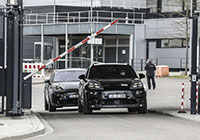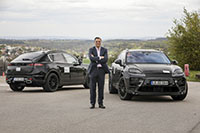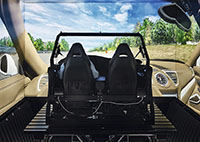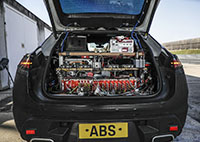
Porsche’s new Taycan is doing a great job of scooping up premium EV buyers, enough so that Tesla may want to consider redesigning its Model S sometime soon. Of course, the iconic California-turned-Texan electric carmaker isn’t likely worried, thanks to a market cap that rivals the largest tech giants, not to mention key models in all of the most important luxury segments, but at least Porsche is succeeding where many others are struggling to gain ground.
Tesla’s Model Y fills the compact luxury SUV hole in its expanding lineup, exactly where Porsche plans to directly compete with an electrified version of its already popular Macan crossover. In order to make sure the Macan EV finds as many buyers possible, Porsche is getting busy testing it on road and track, and recently released some photos and info to let us know how the process is going.
Porsche plans a 2023 launch for its upcoming all-electric Macan, which should be enough time to get the kinks out. To that end, the Stuttgart-based luxury brand had been digitally and physically testing it on its Weissach Development Centre proving grounds until recently, but now has it touring public roads in heavily camouflaged attire, so as to hide its second-generation Macan sheet metal.
“Testing in a real-life environment is now getting underway – one of the most important milestones in the development process,” commented Michael Steiner, Member of the Executive Board, Research and Development, at Porsche AG.

Porsche plans to cover three million kilometres worldwide, in every possible type of condition, ahead of delivering fully electric Macans to market, and that lofty number doesn’t even include the “countless” virtual kilometres accumulated on the Weissach test track, not to mention many more miles achieved via digital prototypes.
According to Porsche, developing the new Macan EV digitally reduces capital expenditures and time, while it also minimizes the new model’s environmental impact. Rather than putting actual prototypes through their paces, a digital computational model replicates the kinds of true-to-life properties, systems and power units of the EV to a very high degree of accuracy. As part of the electrified Macan’s development, Porsche has utilized 20 digital prototypes in order to simulate all types of situations, resulting in critically important aerodynamic, energy management, operation, and acoustic data.
“We regularly collate the data from the various departments and use it to build up a complete, virtual vehicle that is as detailed as possible,” said Andreas Huber, manager for digital prototypes at Porsche, plus one of the first aerodynamics engineers to ever work with digital prototypes. “This allows previously undiscovered design conflicts to be swiftly identified and resolved.”
Reducing aerodynamic drag helps the Macan EV achieve its ultimate range targets, with even minimal flow enhancements making a significant difference.

“We started with a flow-around model when the project first started about four years ago,” added Thomas Wiegand, Director of aerodynamics development.
A team of Porsche engineers utilizes simulations so as to fine-tune each and every surface of the new crossover EV, with specific attention paid to cooling air ducts. Such calculations help the engineers arrange components that in-turn optimize efficiencies, while they also provide the required data for predicting variances in real-world temperature levels. Porsche actually claims the new testing procedures allow for extremely precise simulations of both aerodynamics and thermodynamics.
“The digital world is indispensable to the development of the all-electric Macan,” said Wiegand.
Returning to air ducts and cooling, the new EV’s motive electric system boasts a totally different cooling and temperature control concept than the conventionally-powered internal combustion engine (ICE) powered Macan. To be clear, the various ICE’s used in today’s Macan need a 90- to 120-degree (Celsius) temperature operating range, whereas the new electric-powered model’s drive system and high-voltage battery maintain a temperature window between 20 and 70 degrees.
Also unique to the electric Macan, where an ICE increases its temperature when starting and stopping during heavy traffic, the battery-powered version needs more cooling during high-power charging, particularly in warmer weather. Porsche is overcoming this challenge by calculating and digitally optimizing the “position, flow and temperature” via the digital prototypes mentioned earlier.

Digital prototype use can start quite early in any vehicle’s developmental stage. In fact, Porsche created a completely new driver interface for its upcoming second-gen Macan long before designing some of the other components. A revised driver display was included, of course, which, when ready for testing, Porsche brought to life in a “seat box” that was capable of simulating the actual driving environment.
“Simulation allows us to assess displays, operating procedures and the changing influences during a journey from the driver’s point of view,” said Fabian Klausmann of Porsche’s Driver Experience development department. “Here, the ‘test drivers’ are not just the specialists themselves but also non-experts. This allows all interaction between driver and vehicle to be studied down to the last detail, enabling selective optimization even before the first physical cockpit has been built.”
The initial physical Macan EV prototypes were developed from information learned through the digital prototype program, and once these running prototypes were on the track, they fed additional data back to the digital prototypes to continue testing with. This process allowed Porsche’s engineers to continually update both the digital and physical prototypes, refining each aspect of the Macan EV throughout the development process.
“Endurance testing on closed-off testing facilities and public roads in real-life conditions is still indispensable to ensure that the vehicle structure, operational stability and reliability of hardware, software and all functions meet our high-quality standards,” continued Steiner.

The Macan EV continues to undergo a demanding testing process, including climate extreme endurance tests, plus the need to overcome all types of topographical conditions. Of course, this would include real-world charging and conditioning of the new EV’s high-voltage battery, with everyday reliability and segment-leading performance being high on the agenda.
“Like the Taycan, the all-electric Macan, with its 800-volt architecture, will offer typical Porsche E-Performance,” added Steiner, pointing to development goals such as the SUV’s long-distance range, high-performance fast charging, and goal of best-in-segment performance. “The all-electric Macan will be the sportiest model in its segment.”
The new Macan EV will also need to be highly efficient, of course, which is why it’s the first Porsche to make use of the brand’s new Premium Platform Electric (PPE) architecture. This said, most Macan owners will continue choosing one of the automaker’s conventional ICE’s instead of the electrical alternative, at least in its early years, particularly in markets where consumers aren’t penalized for not going green, thus gasoline-powered models will need to remain part of the overall Macan package for the unforeseen future.
“In Europe, demand for electric vehicles continues to rise, but the pace of change varies considerably across the world,” noted Steiner. “That’s why we’re going to launch another attractive conventionally-powered successor to the current Macan in the course of 2021.”

This said, the new second-generation Macan will launch later this year, with varied availability of ICE’s. The new Macan EV will follow in about three years and millions of kilometers of digital and physical prototype tests.
Until then, today’s 2021 Macan is available from $57,800, and can be had with factory leasing and financing rates from zero percent. Be sure to check out each and every available trim in our 2021 Porsche Macan Canada Prices page, and configure those you’re most interested in with all options and colours, and then find out how you can save when purchasing your new Macan (or any other new vehicle) by becoming a CarCostCanada member. Currently, Macan buyers are saving an average of $2,750 thanks to dealer invoice pricing, which is information you can now have on hand after downloading the free CarCostCanada app from the Google Play Store or Apple Store.
Story credit: Trevor Hofmann
Photo credits: Porsche
